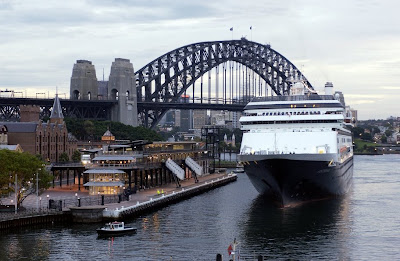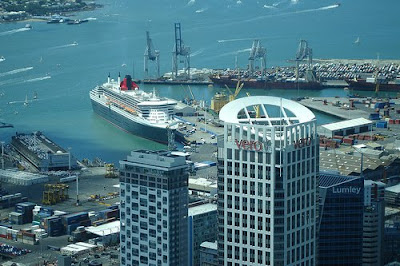"Queens Wharf is to be spruced up for the Rugby World Cup at a cost of about $10 million.
It is understood there is no political appetite or funding to proceed with a grand design for the wharf in the foreseeable future.
Last month, political leaders called a halt to the much-maligned design contest to turn Queens Wharf into a combined cruise ship terminal and "party central" venue for the 2011 Cup.
A joint entry from architects Jasmax and Architectus, featuring a ramp to the water at the end of Queens Wharf, was the winning design for the $47 million budget...."
 The Herald even ran a picture of the winning design with that story. The winning entry was known as QW04. The Herald even ran a picture of the winning design with that story. The winning entry was known as QW04. |
 I quite liked the variant of that design that was in the design competition. One of the reasons I liked it was because the Cool Shed was retained, and featured. I quite liked the variant of that design that was in the design competition. One of the reasons I liked it was because the Cool Shed was retained, and featured. |
Anyway. I digress. Things have been moving along apace. Yesterday, an extraordinary meeting of ARC Council was called by ARC's Chairman.
It was all about Queens Wharf. I can't really go into detail here - because the item was in confidential. A slim majority of councillors were able to attend - almost half the ARC councillors had made other Xmas arrangements and were elsewhere.
So a bare quorum attended. I was not happy to be considering such an important matter with so little time to think about it, and with so few councillors there. And there was no real sense of urgency. A strong whiff of expediency or ad hockery (if that's a word) was in the air....
The Chairman of ARC has made no secret of his desire to get rid of the Queens Wharf sheds, and to build Auckland's primary cruise ship terminal there. Quite a few other councillors, not to mention a fair slice of Auckland's media and public are concerned by that proposal. That it will restrict the opportunities to provide for public waterfront amenity. Crowd Auckland's CBD waterfront with cruise ships and basically give over the cruise ship industry a fantastic slice of Auckland's central waterfront. Here's how ARC's Chairman describes what he wants in his November report to Council. This photo is part of his report:
You get the picture. ARC's Chairman is VERY enthusiastic about cruise ships and the cruise ship industry. He still wants BOTH sides of Queens Wharf to be available for cruise ships - that's why he likes the picture he has in his report with 3 cruise ships.
I have had to push very hard to get the idea of public space provision on Queens Wharf to be included at the same level in ARC's thinking - as the cruise ship terminal. It's there, as you can see in the Chairman's report, but I think public space and public amenity continues to be vulnerable to the pressure for Queens Wharf to be Auckland's PRIMARY cruise ship terminal.
So - what can I tell you about the confidential meeting? Well. It seems that the powers that be are interested in doing rather more than the $10 million Party Central do-up that the NZ Herald reported a few weeks ago.
Behind the scenes a lot of work has been going on to titivate and tart up the design competition winning entry (described above), so that it meets the expectations of those same powers that be who would quite like to get the whole thing done in time for Rugby World Cup. The detail of all of that was provided at the meeting. Of course there are conversations to be had, and deals to be done, and funding to be found and finalised, and other design details to be worked through, and nothing was actually finalised.
But it's a worry. Not quite in the spirit of due process.
A strong whiff of ad hockery. Another classic Auckland moment. Reminiscent of Mallard's stadium Auckland moment. Is this the only way Auckland can do anything? And if we seriously believe Auckland governance needs to be changed to get good decisions, do we really think it appropriate to allow the existing dying regime - or even a fragment of it - to decide anything as precious as the waterfront?
I won't say any more about that meeting. But I am happy to share some of the concerns I had, and some of the research I carried out before the meeting. First of all I am aware that the Design Competition Panel prepared a final report. This recommends that QW04 is the winning entry. My understanding is that the main reason it won is that it scraps Shed 10, to ensure that the cruise ship terminal part of its design can deliver the rigid requirements of the design competition brief. The brief is onerous. It talks about the need for 8000 square metres of cruise ship building space. It talks about other building requirements to meet the needs of the cruise ship industry. It turns out that there is no way these specified needs can, or could, be met by any adaptive re-use of Shed 10. That is a principle reason why QW04 won.
In other words, the price of the cruise ship terminal, is Shed 10. The Design Panel basically found that you can't have both. And clearly the security and other needs of the cruise ship terminal will always rule when it comes to public space and provision as well. And if the ARC Chairman has his way, both sides of Queens Wharf will be sacrificed to cruise ship heaven. To P&O et al.
It is plain stupid to shove ships into and almost onto Auckland's downtown CBD waterfront. This space needs to be reserved for promenading and public amenity and public fun.
What is happening is not a positive reflection on Auckland planning. I say, let's stop this waterfront ad hockery. By all means spend $10 million - or even $20 million - on Party Central on Queens Wharf. But don't rush something ill-thought-out onto Queens Wharf. It's too precious.
POSTSCRIPT (dated 15th January 2010). You will have noted the discussion in NZ Herald over the past few days. Orsman's front page reveal all was triggered by this blog. The subsequent debate has engaged the attention of the PM who has blocked proposals for a major and hasty redevelopment. Interestingly, Cooper and Company have come up with a "redevelop 30 metres of land behind the red fence and keep Quay Street as it is". Which has a degree of popularity about it. I think it's another short term fix. Quay Street's use has to change otherwise Auckland CBD will be separated from its waterfront by a traffic artery/sewer.























 And here's another view of that square. Apparently it was privately developed to specification, but has now transferred to Auckland City Council. So it's a great public space - a plazza - or piazza. With interesting shade, seats round the perimeter, and surrounded by buildings which will shelter the space from weather. You enter the square on sweeping wide steps from the station.
And here's another view of that square. Apparently it was privately developed to specification, but has now transferred to Auckland City Council. So it's a great public space - a plazza - or piazza. With interesting shade, seats round the perimeter, and surrounded by buildings which will shelter the space from weather. You enter the square on sweeping wide steps from the station.


















